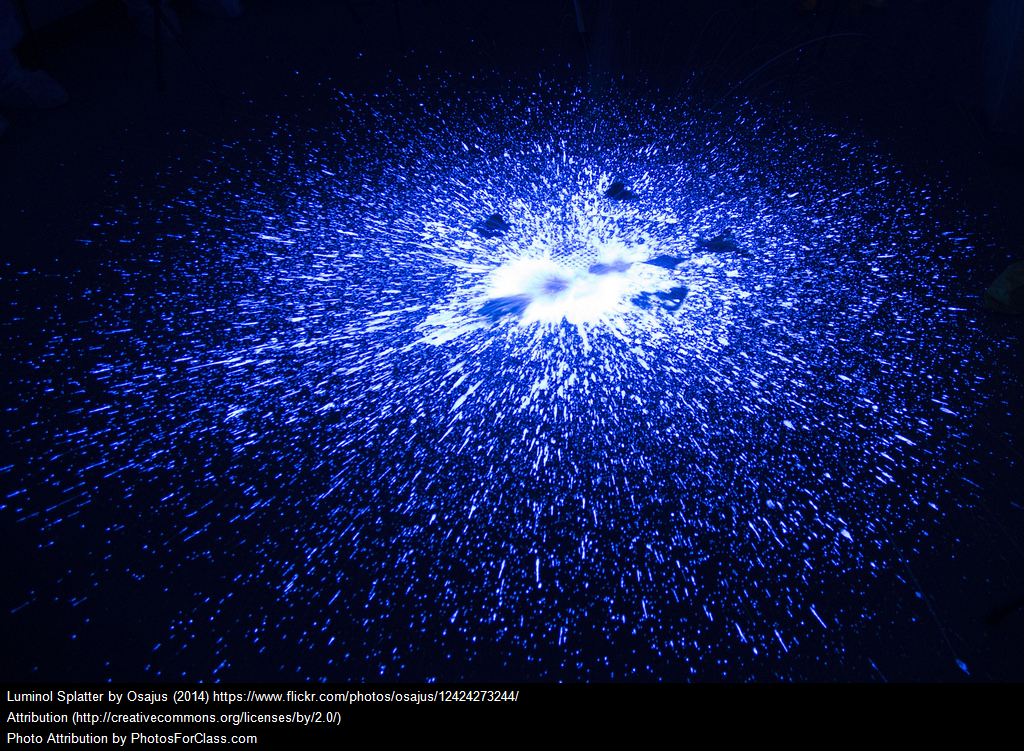Review: Improving Luminol Blood Detection in Forensics
Florida Forensic Science : 01.03.2017
(Emily C. Lennert)

Article to be reviewed:
1. Stoica, B. A. ; Bunescu, S. ; Neamtu, A. ; Bulgaru-Iliescu, D. ; Foia, L. ; Botnariu, E. G. “Improving luminol blood detection in forensics”. Journal of Forensic Sciences. 2016, 61 (5), 1331-1336.
Keywords: serology, blood, luminol, chemiluminescence, intensity, hemoglobin, urea, cyclodextrin, bleach, oxidation, denature, Weber method, Weber solution
Disclaimer: The opinions expressed in this review are an interpretation of the research presented in the article. These opinions are those of the summation author and do not necessarily represent the position of the University of Central Florida or of the authors of the original article.
Summary:
Luminol is a common method for preliminary identification of blood. While other types of presumptive tests for the identification of blood exist, luminol remains as a frequently used method world-wide. This is partially due to its ability to be used to screen large areas for the presence of blood. However, in spite of its popularity, luminol has well known shortcomings, such as lack of specificity, which may lead to false positive indications of the presence of blood, and the requirement that the test be performed in complete darkness for best results.
The Weber method is a common protocol for preparation of a working luminol solution. Generally, luminol is dissolved in sodium hydroxide to create a stock luminol solution. Then a “working solution” is prepared by combining the luminol solution with additional sodium hydroxide, hydrogen peroxide, and purified water. The working solution may then be sprayed onto surfaces to test for the presence of blood. A positive result for luminol can be seen as the emission of blue light, a process referred to as chemiluminescence. The intensity and duration of chemiluminescence may depend on what the luminol is reacting to, i.e. blood or bleach, as well as the quantity of the reactant, meaning more concentrated samples will produce more intense chemiluminescence. Due to variability in time and intensity of chemiluminescence, chemiluminescence cannot reliably indicate what the luminol is reacting to. However, increasing the time and intensity of chemiluminescence is still a goal for researchers because it will enable crime scene investigators to visualize positive results more clearly. Luminol undergoes a chemical process called oxidation, which, for luminol, ends in the release of energy that can be seen as visible light, i.e. chemiluminescence. Hemoglobin, a protein found in blood, enhances the oxidation of luminol. When blood and luminol come into contact, the hemoglobin speeds up the oxidation of luminol and produces the chemiluminescence that indicates the presence of blood.
Two issues with luminol are of particular interest in this research. The first is the intensity and time of chemiluminescence; this research aims to increase both time and intensity, and the second is to eliminate false positives caused by sodium hypochlorite, i.e. bleach. The second aim is more challenging because bleach is a strong oxidant as well and will result in a chemiluminesce response in the absence of blood. . First, 5mm diameter absorbent fiber disks were soaked with 20μL of human blood. Then, dilutions of the blood on the disks were made ranging from 1:1 to 1:100,000. All of the disks were placed into the wells of 96-well plates. 40μL of the luminol working solution, prepared according to the Weber method, was added to each disk. Chemiluminescence measurements were made using a plate reader, chemiluminometer, which measured the intensity of light 17 seconds after the addition of working solution.
Urea experiments:
For some disks, an 8M urea solution was used to pretreat the blood soaked disks for 20 minutes prior to the addition of the working solution. Urea was used to partially denature, or break down, the hemoglobin to enhance the chemical properties of the reaction. The authors theorized that, if the chemical properties of hemoglobin could be enhanced, the intensity and time of chemiluminescence would be greater. Additional disks were prepared on which a 30% sodium hypochlorite solution was applied to the blood soaked disks prior to pretreatment with urea.

Urea results:
Urea treated disks were found to produce chemiluminescence of stronger intensity for all levels of blood dilution than just luminol alone. Additionally, the higher intensity was maintained for at least 100 seconds, as seen in figure 3(c) within the study. For the disks treated with only bleach, pretreatment with urea is reported to have removed the false positive that results from the reaction of luminol with bleach. Figure 6 within the study displays the chemical decomposition of bleach in the presence of urea. During the 20 minute pretreatment period, urea breaks down the sodium hypochlorite molecules. Then, when the luminol working solution is applied, the chemiluminescence that occurs is due to the presence of blood only, rather than the sodium hypochlorite (bleach) molecules, which no longer exist. Although the intensity of chemiluminescence that occurs due to the presence of blood in the urea treated sample is low when compared to a sample of blood alone, a positive result can still be detected.

Cyclodextrin experiments:
On other disks, cyclodextrins were added after the addition of the working solution. Cyclodextrins are cyclic, sugar based molecules, and the research study reports that previous studies had used some types of cyclodextrins to enhance the intensity and time of chemiluminescence by luminol. This study tested seven different cyclodextrins at varying concentrations, to determine what cyclodextrin, and how much of it, would produce the best enhancement of chemiluminescence. Chemiluminescence measurements were taken using the chemiluminometer for all disks.
Cyclodextrin results:
Of the seven cyclodextrins examined, monochloro-triazinly-β-cyclodextrin (MCT-β- CD) was found to produce the best enhancement of intensity. A MCT-β-CD concentration of 15mM was found to be optimal for enhancement of the chemiluminescent intensity. MCT-β-CD was found to be more effective than luminol alone, i.e. the Weber method, even when the blood was more diluted.
Scientific Highlights:
- Experiments were also conducted within this study to verify the theory of hemoglobin denaturation’s effect on chemiluminescence and the effect of urea on hemoglobin. This was used to verify the reasoning behind the use of urea as a pretreatment process that reduces false positives.
- Monochloro-triazinly-β-cyclodextrin (MCT-β-CD), at a 15mM concentration, may be used to enhance the intensity of chemiluminescence.
- Pretreatment with 8M urea may increase the time and intensity of chemiluminescence.
- Pretreatment with 8M urea may eliminate false positives due to sodium hypochlorite, i.e. bleach.
- Denaturation, or break down, of the hemoglobin protein appears to contribute to enhanced chemiluminescence.
Relevance:
Luminol is a common method of blood identification, however, it is not without faults and can be improved upon.

Potential conclusions:
While luminol is a common tool for field identification of blood, the test is prone to false positives due to bleach, a popular household item. Improvements can be made to increase the usefulness and efficiency of luminol and mitigate the impact of false positives. Urea and some cyclodextrins, such as MCT-β-CD, may enhance chemiluminescence, making luminol a more useful tool.
Legal Brief: Improving luminol blood detection in forensics (Steve Krejci)
From a trial lawyer’s perspective, determination of whether luminol was used in a case is a critical issue for a couple of reasons. First of all, luminol does not react with blood alone. The iron present in blood, not just human blood, is what reacts with luminol to emit light.1 So, not only will any animal blood trigger such a reaction, other items can catalyze, or speed up, the reaction and will lead to the emission of light. Some items that can do this include bleach, copper, urine, fecal matter, and horseradish.2, 3, 4 Therefore, the use of luminol to draw inferences such as crime scene exits, movements of persons, and attempts to clean up crime scenes are subject to cross examination on wholly innocent explanations. Second, if blood is detected and subsequently analyzed, luminol is now a contaminant that must be accounted for. However, the use of luminol will not interfere with the ability to do subsequent DNA analysis.5

Sources :
- The Chemistry of Bluestar Forensic, BLUESTAR FORENSIC, available at http://www.bluestar- forensic.com/gb/bluestar-chemistry.php, (last accessed Nov. 8, 2016).
- High Intensity Chemiluminescence ELISA Substrate, HAEMOSCAN, available at: https://www.haemoscan.com/products/lum-substrate/, (last accessed Nov. 8, 2016).
- Luminol (Blood), BUREAU OF CRIMINAL APPREHENSION: A DIVISION OF THE MINNESOTA DEPARTMENT OF PUBLIC SAFETY, available at https://dps.mn.gov/divisions/bca/bca-divisions/forensic-science/Pages/forensic-programs-crime-scene.aspx, (last accessed Nov. 8, 2016).
- Marek Ples, Chemiluminescence Luminol Activated Ferricyanide, WEIRD SCIENCE, available at https://weirdscience.eu/Chemiluminescencja%20luminolu%20aktywowana%20%C5%BCelazicyjankiem.html , (last accessed Nov. 8, 2016).
- Gross, A. M. et al. “The effect of luminol on the presumptive tests and DNA analysis using the polymerase chain reaction.” Journal of Forensic Science, 1999, 44, p 837.
#serology #blood #luminol #chemiluminescence #intensity #hemoglobin #urea #cyclodextrin #bleach #oxidation #denature #Weber #method #Weber #solution
Inscrivez vous à notre newsletter :
Pays
Année
Archives
- July 2023 (1)
- March 2023 (1)
- September 2022 (1)
- April 2022 (1)
- February 2022 (1)
- January 2022 (1)
- November 2021 (1)
- October 2021 (1)
- September 2021 (3)
- June 2021 (2)
- May 2021 (3)
- November 2020 (1)
- October 2020 (1)
- August 2020 (1)
- June 2020 (1)
- February 2020 (1)
- October 2019 (1)
- September 2019 (1)
- May 2019 (1)
- April 2019 (2)
- August 2018 (2)
- July 2018 (1)
- June 2018 (1)
- May 2018 (1)
- February 2018 (1)
- January 2018 (1)
- May 2017 (4)
- March 2017 (1)
- August 2016 (1)
- July 2016 (1)
- January 2016 (1)
- June 2015 (1)
- July 2014 (2)
- March 2014 (1)
- September 2013 (3)
- June 2013 (1)
- December 2010 (1)
- June 2010 (1)
- January 2010 (1)
- March 2009 (1)
- March 2008 (1)
- September 2007 (1)
- July 2006 (2)
- August 2005 (1)